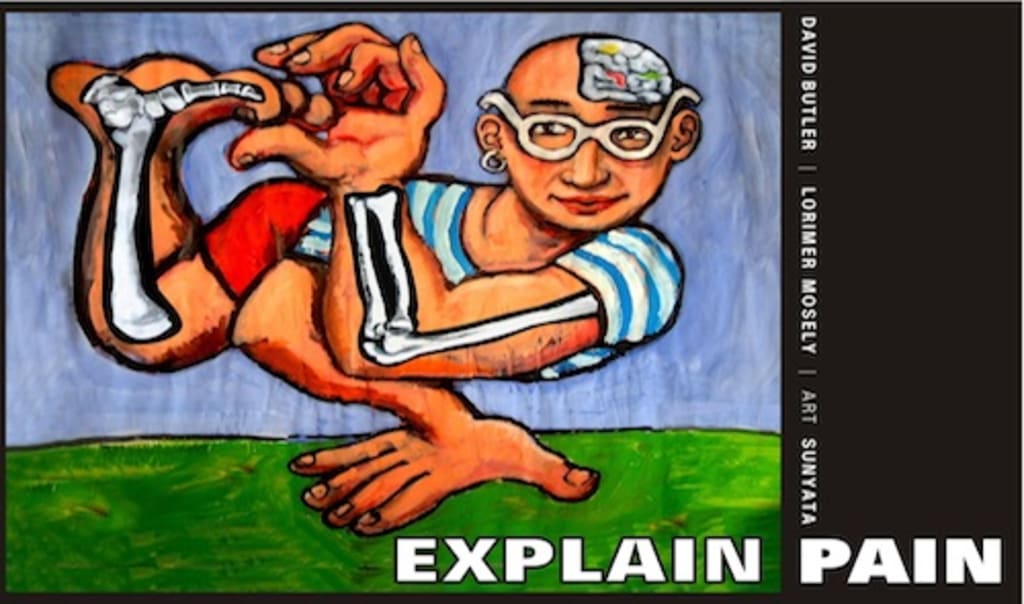Can We Finally Explain Pain?
We're so much further than you think

I imagine if you’re reading this, you have probably experienced some form of pain in your life. You may have stubbed your toe on a coffee table, or become sore in your shoulders after months of working from home, or maybe you have had unresolved lower back pain for years.
Same here.
When I was 18, an accident at gymnastics training led to me having unrelenting lower back pain. I had just started University and went from touching my toes with my wrists for minutes at a time every morning and somersaulting, to struggling to pick up my bag from the bed to head to lectures. I was referred for an MRI. “Great”, I thought, I’ll find out what’s wrong and handle it from there.
But the MRI wouldn’t take place for another month. So I did my best to get by day-to-day and gradually make things a little bit easier for me. I had very difficult days and some surprisingly easy days physically. Eventually, I started to ease myself back into light aerobic activities and before I knew it, I was even able to complete a gentle shoulder session at the gym with no problems.
I felt great! 3 weeks on and I felt like I was on the right trajectory. Maybe I’ll even be able to squat with a barbell on my back next month?
But then a week later, the MRI came.
“You have a double disc herniation at L3 and L4”.
I could feel my whole body tighten up.
I left the hospital thinking “Oh wow it’s quite bad. But I’ve been recovering well so it hopefully won’t take too much longer”.
Little did I know I would go straight back to square one whilst trying to untie my shoelaces the second I got home.
I couldn’t understand it. It took a high-speed impact on my back for the pain to start in the first place. I’m getting back to the gym and all I had done was walk home from the hospital. What had happened?
Four and a half years later and I think I now know the answer.

A significant factor in the development of my understanding of pain especially, is thanks to Lorimer Moseley and David Butler. Their book “Explain Pain” has revolutionised how I and many others think about and address their pain.
Thank you, Lorimer, David, and The Pain Revolution.
1. PAIN IS ALWAYS REAL, NO MATTER WHAT IS CAUSING IT
A builder reported to A&E after stepping on a nail at work and was sedated with fentanyl and midazolam whilst he was there.

“Smallest movement of the nail was painful…he was sedated with fentanyl and midazolam” — British Medical Journal
Fentanyl is an opioid, which on its own wasn’t even enough to mitigate his pain.
The medics eventually managed to remove his foot from the shoe but discovered that things weren’t what they had first seemed to be. The nail had gone between the man’s toes and there was no structural damage to his foot. No injury, but in inconceivable pain.
His pain was REAL. It was so bad he needed opioids, but there was no damage.
Pain is REAL no matter what.
2. Pain Relies on CONTEXT and CUES
Lorimer Moseley conducted an experiment in 2007, whereby a cold (-20 degrees Celcius) metal rod was associated with a red or blue light. This rod was then placed onto the back of a normal and healthy participant’s hand and they were shown a red light (meaning HOT) or a blue light (meaning COLD). Nothing was said in relation to the context of the lights and the metal rod.
Participants then gave their results along a pain scale (0–10) to represent how much it hurt when the metal rod was placed on their hand with either the blue or red light showing.

Now even though there was no change in the stimulus, the levels of pain for the majority of the cohort were at their highest when the red light was shown, which we would associate with hot. Whereas when the blue light was shown it was generally much lower. We realise the CONTEXT of these CUES and a physical response are produced as a result of that. In this case, pain.
But the participant who has a similar score between the two stimuli (horizontal line) is not picking up on the same CUES as the other subjects, to have a pain-like experience: Moseley & Antz 2007 Pain.
3. Pain is all about PROTECTION
Pain is NEVER an indicator of the state of your body’s tissue. It’s about protecting those tissues. Despite them being seeming similar, they are slightly different.
Let's consider a violinist: The fingers on their left hand will go through a much higher dose of work compared to their right through their musical career.

The fingers on their left hand are more conditioned than those of the right. But they are more sensitive to painful stimuli because they need to be PROTECTED, more than the right side.
It has also been discovered that anything that implies something needs protecting, will increase levels of pain. Whereas anything that suggests something does not need protection will take the pain levels down.
ANYTHING.
This is what happened to me after I received my MRI results.
After I was told about what the MRI of my lower back showed, my pain became worse. I tried to complete tasks that I had been able to do with little to no pain for a while and then all of a sudden, I could not. What had changed? It was suggested that my lower back needed protection.
Little did I know I would be told by one of my University lectures later on that week that you actually decrease your chances of quicker recovery after you have an MRI. It is only a small effect, but nonetheless it is still an effect.
My first reaction, like a lot of people’s, was “Why was I not told sooner?!”.
Thankfully I would make a full recovery over the next few months. But knowing what I know now, I could only imagine how much quicker it would have been, had I not had the MRI.
4. Pain and Tissue Health are POORLY Related
How many of you have twisted your ankle and it consequently swelled up?
For the majority of cases, the pain significantly decreases two weeks later after the incident has occurred. But that doesn’t mean the structure is back to where it was pre-injury. The tissue has not made a complete recovery.
It would take six weeks for the tissue to return to a somewhat normal state. But the pain is already gone? The pain is only telling you to PROTECT your ankle, not the state of the health of the tissues. The pain has stopped because your ankle no longer needs complete PROTECTION.

This graph was built to show us that we can have pain BEFORE an injury.
Don’t believe me? Let's test this.
Pinch the tip of your thumb as hard as you can (unless you have damaged that thumb recently) and then stop when it hurts. Now, there’s no way you will have severely damaged yourself.
But you had pain.
The pain is not telling you the state of the tissues in your thumb — it’s telling you to stop. To protect it.
Another remarkable proposal from this graph is the dramatic decline in pain levels, once an injury becomes catastrophic. For example, if a crocodile rips your arm off, there’s no point making your shoulder hurt because you need to survive. That’s because the brain produces pain and your body realises the significance in acting to save your life, instead of being in pain.

Another example of this comes from a World War II Veteran. This gentleman had an X-ray on his neck 60 years after serving. The X-ray illustrated that he had a bullet in his neck.
He had no idea when it arrived. He did remember coming under fire from the enemy, but he never had pain from it. Remarkable. In this situation, the pain would have been no use to him, as he needed to protect his LIFE, instead of just his neck.
The next example should be a lot more applicable to everyone reading this.

I’m going to make a fair estimate that a lot of people reading this have experienced or are currently suffering from some form of back pain.
So many people are told after scans that they have a “disc bugle” or “disc degeneration”. This is a hammer blow for a lot of people.
The table above shows the percentage of people who HAVE those pathologies but DO NOT have back pain. My mum is in her fifties and does not have any back pain. However, if she were to get an MRI, then it would more than likely show that she has disc degeneration. Again, she is PAIN-FREE.
Look at the group of participants in their sixties. Nearly ninety percent of people within that age group have disc degeneration but are not in pain.
Pain is not a measure of damage, instead, it is trying to protect your body from future damage. Once we find out why that is happening, we can start to change it. Although finding out why is not easy.
5. We Are Adaptable, Bioplastic Learners
Our bodies learn and adapt very quickly. That is what bioplasticity eludes to. So the longer you are in pain for, the better your nervous and immune system becomes at generating pain.
You learn pain.
You don’t have any control over it but it is an adaptation within your nervous system. This becomes a real challenge for Healthcare Professionals (HCPs) because the pain is coming from the tissues, but the problem lies within the nervous system.
But this is also a really exciting thing for HCPs because we now know that we can retrain the body’s system, once you understand.
The image below is perhaps one of the most famous from Lorimer Moseley’s and David Butler's book “Explain Pain”. It demonstrates how much of an activity you could complete prior to pain beginning to develop.

Then this buffer works in order to initiate pain before you damage any structures.
If you have dealt with pain for a long period of time, the largest impact on your biology and therefore your life is the enlargement of the size of this buffer. This increases because your nervous and immune system has learned how to efficiently produce pain, to seemingly protect your body.
So you will get pain despite not necessarily being in any danger. But it is real because ALL PAIN IS REAL, no matter what it is that is causing it.
The challenge that is subsequently produced for anyone in pain, is to understand why their brain is protecting and how to gradually decrease the size of their buffer.
The language that we now use as HPCs is that your system is overprotective. Your pain does not mean you are broken beyond repair.
Your SYSTEM is overprotective.
6. Movement is KING
This has become one of the most critical aspects of beginning the journey to retraining our system and becoming pain-free.
Over time, the movement will start to suppress the pain and will help you learn what is and is not dangerous for your body. It helps to maintains a small buffer.
Movement also protects you against potential problems that will develop as you get older.
It is the best way to recover within a wider situation.
Even imagining movement can prove to be extremely helpful. Patients who have such severe pain can find it difficult to even flex their wrist (for example) and it can become intolerable. The way that HCPs are beginning to retrain the systems of these people is through getting a patient to imagine flexing their wrist. That is how little of a level of exposure is needed to create an adaptation within the nervous system. Then that is slowly built up. Then gradually over time they can flex their wrist pain-free and slowly over time, they can get out of their wheelchair, get rid of their supports, and so on.
Meaning the key for a lot of people is to find the tolerable line that they can physically reach, without flaring up and slowly progressing from there.
Unless you understand pain, there will be no sense in doing something or completing an activity, despite certain levels of pain. It will make no sense to understand you are safe doing an activity, even though it hurts. Therefore it definitely will not make sense, how you need to slowly progress this to retrain your system.
7. Understanding Pain & Retraining Your System Works
One thing that has slowly emerged over time is that this development of an understanding of pain and retraining your overprotective system does work. But it is by no means a quick fix. You have to take a journey with it.
If you have the correct resources, a team of HCPs, and coaches around you then it will put you onto the right trajectory and you will recover.

The graph above highlights the typical data that has been seen within rehab.
In this example, people who were taken through a program where it was only “Tissue or drug” focussed tended to stagnate and their levels of pain did not really change. That is something that will be relatable to a lot of you. But the group who went through the “Understand & Retraining approach”, had a vastly different outcome. This is what can happen if HCPs teach you to understand your pain and retrain that system.
That sort of progress is hard. It took them six weeks just to generate a small change in the pain scale scores. Three months down the line and it was a similar story. But twelve months later there was a significant change in their levels of pain. Because they stuck with it.
Your levels of pain can decrease too. If you stick with it.
We can not offer an immediate fix. No one with chronic levels of pain will recover in a couple of weeks. Unless it is a complete fluke.
If we are going to be able to retrain your system and get you back to your life with no problems, then we need to take a journey.
Below there will be a list of the journals where the concepts and findings posted in this article have been published. Also, there will be a list of organisations that are officially endorsing this approach.
Like the journey people will take with their rehabilitation, this article was never going to give you a quick fix. It was not written for that purpose. But hopefully, this will plant the seed of interest and point you in the right direction in your own journey to becoming pain-free.
The next conversation that you have with your GP, Physiotherapist, Sports Therapist, or Occupational Therapist should be: “Tell me about the journey of how I can begin to understand my pain and how do I retrain my system.”.
Engage with a new sense of what is possible, within recovery.
Take the leap.
Journals:
Arthritis Care & Research
JAMA Internal Medicine
The Clinic Journal of Pain
British Journal of Sports Medicine
Journal of Physiotherapy
Archives of Physical Medicine and Rehabilitation
European Journal of Pain
The Journal Of Pain
Neurorehabilitation and Neural Repair
Organisations:
International Association for the Study of Pain: https://www.iasp-pain.org/
American College of Rheumatology: https://www.rheumatology.org/
The Australian Pain Society: https://www.apsoc.org.au/
Nederlandse Vereniging voor Anesthesiologie: https://www.anesthesiologie.nl/
The British Pain Society: https://www.britishpainsociety.org/
Australian Psychological Society: https://www.psychology.org.au/
World Confederation for Physical Therapy: https://world.physio/
European Pain Federation: https://europeanpainfederation.eu/
Australian Physiotherapy Association: https://australian.physio/
American Physical Therapy Association: https://www.apta.org/
The Pain Revolution: https://www.painrevolution.org/
About the Creator
Rhys Burton
Healthcare Professional working in Elite Sport. Just looking to help one person at a time.






Comments
There are no comments for this story
Be the first to respond and start the conversation.